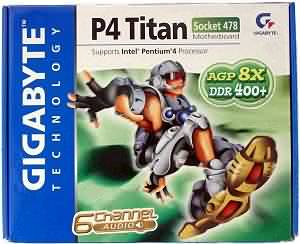Gigabyte
8SG667 (SiS648) Mainboard
|

The company has a wide range of boards in its arsenal: from no-frills budget
solutions to top models which takes pages to list all of them. And today we have
a plain offering without extra niceties. Accessories: -
Package of a standard design;
- Documentation: user manual, poster
with installation instructions - in English;
- Cables:
1 ATA66/100/133, 1 ATA33 and FDD;
- Bracket with 2 USB ports;
-
2 CDs containing:
- drivers;
- DirectX 8.1;
-
Adobe Acrobat Reader;
- Norton Internet Security 2002;
-
Gigabyte EasyTune 4;
- Gigabyte Face Wizard;
- Gigabyte
Windows Utility Manager;
- Gigabyte Management Tools.

Convenience is sacrificed to the dimensions: the 20 cm wide board forces us
to bear with its flaws. Though there are not many downsides, or rather, they are
traditional and peculiar to most full-sized samples: audio-ins are in front of
the PCI, and the IDE are behind them, and the power supply connectors are tucked
in between the back panel and the processor's socket, and when a video card is
installed it's difficult to handle the memory modules. The board has no switches
or jumpers. The 2-channel switching voltage regulator incorporates 2
capacitors of 3300 uF and several less capacious ones. (this is not much at all,
though the board is oriented towards the budget segment; but it contradicts to
the wide overclocking capabilities provided in the BIOS). The following
controllers are integrated: - audio controller based on the chipset's
capabilities and Avance Logic ALC650AC'97 codec supporting 5.1 audio systems and
having connectors for front audio inputs/outputs and for SPDIF;
Non-unsoldered
connectors: network controller and RJ45 connector. The system monitoring
is supported by the ITE IT8700F chip. What is controlled: - processor
voltage, 1.8, +3.3, +5 and +12 V;
- speed of 2 fans;
-
temperatures of the processor (a built-in sensor) and the board (a built-in sensor).
There
are 2 connectors for adjustable connection of fans. Brief characteristics
of the board: memory slots - 3 DDR SDRAM; expansion slots - AGP/ 5 PCI; I/O
ports - 2 COM/ LPT/ 2 PS/2/ 6 USB 2.0; dimensions - 305x200 mm. Adjustment
can be carried out with:
| BIOS based on the 6.00 version from
Award | Setup of memory timings | + | Top Performance |
| Setup of memory frequency | + | Auto, DDR200,
DDR266, DDR333, DDR400 | | Setup of AGP bus | - | |
| Setup of PCI bus | - | | | Changeable
scaler of AGP and PCI buses | + | AGP(PCIx2) = 60-255
MHz in 1MHz steps | | Manual assignment of interrupts | + | |
| Changeable FSB frequency | + | 100-355 MHz in
1MHz steps | | Changeable CPU multiplier | + | x8-x50 |
| Changeable core voltage | - | | | Changeable
memory voltage | + | Normal, +0.1, +0.2 V | | Changeable
chipset voltage | - | | | Changeable AGP
bus voltage | + | Normal, +0.1 V | We
used the latest available version of the BIOS - BIOS F3. Judging by the
functions and components of the board, it seems to be a match for those who want
an inexpensive office system, but incredible overclocking potential of the BIOS
(255 MHz on the AGP - is your video card ready for such torture?) confuse and
even frighten me :).
Test results:
Write a comment below. No registration needed!
|
|


